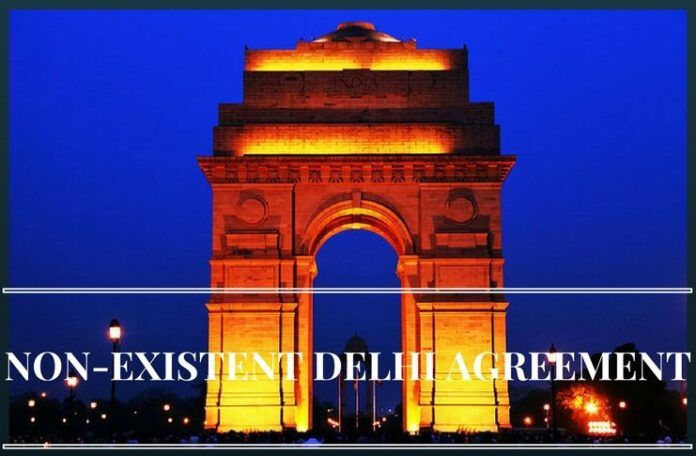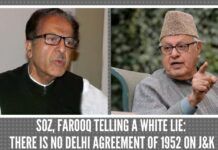
Maroof Raza needs to revise his views on the non-existent Delhi Agreement of 1952
[dropcap color=”#008040″ boxed=”yes” boxed_radius=”8px” class=”” id=””]S[/dropcap]peak a lie a hundred times and it becomes a truth. It has actually happened. The National Conference (NC) President and former three-time Jammu & Kashmir (J&K) Chief Minister, Farooq Abdullah; his son and NC working president, Omar Abdullah; and his close lieutenants wanted the nation and the media, both print and electronic, to believe in something which did not really exist. And, they have succeeded. This is evident from the April 28 “News Hour Debate” on historic April 28, 2017, Supreme Court observations and the Government of India’s flat refusal to talk to those in Kashmir who preach “Azadi” and separatists of all varieties. The Supreme Court went by the Government of India’s stand on the political status of J&K vis-à-vis India and clearly said that there was no place for stone-pelters in Kashmir.
The highly sophisticated and well-informed strategic affairs expert on Times Now Maroof Raza talked about something during the debate, which didn’t exist at all. They talked about the non-existent Delhi Agreement, 1952.
The “News Hour Debate” (10 to 11 p.m.) was both interesting and disturbing. It was interesting because the Congress’ spokesperson Alimuddin Khan said something which no Indian had ever expected. He, inter-alia, twice said: “Bomb Article 370 and abrogate it immediately and bring the restive J&K under the President’s Rule”. He, in fact, sprung a big surprise. It was disturbing because the ruling People’s Democratic Party (PDP) spokesperson and former MLC, Nizamuddin Bhat, and the otherwise highly sophisticated and well-informed strategic affairs expert on Times Now Maroof Raza talked about something during the debate, which didn’t exist at all. They talked about the non-existent Delhi Agreement, 1952.
[dropcap color=”#008040″ boxed=”yes” boxed_radius=”8px” class=”” id=””]T[/dropcap]he NC leaders’ assert again, again and yet again that the then Prime Minister, Jawaharlal Nehru, and the J&K Wazir-e-Aazam, Sheikh Abdullah, and their aides got involved in negotiations between June 14 and July 24, 1952, in order to work out an arrangement that shall regulate the Center-State relations and that the outcome of these lengthy and tortuous parleys was what they term as the “Delhi Agreement”, signed on July 24 by Nehru and the Sheikh. But this is just one side of the case. The other is far more interesting and startling. It, in the words of Farooq Abdullah, is that “it was the Parliament which (ratified the Delhi Agreement and) promised autonomy” and that “the bill (to this effect was) piloted (on July 24) by (the) then Prime Minister Jawaharlal Nehru”.
It bears recalling that it was in 1992 that Farooq Abdullah and his out-of-power Jammu and Delhi-based Kashmiri associates unleashed a no-holds-barred campaign to convince the Indian nation, the Parliament, the authorities in the South and North Blocks and the media that the root cause of the “Kashmiris’ alienation” was the conspiracy hatched by New Delhi and its power-hungry Kashmir agents to subvert the Delhi Agreement and bring J&K surreptitiously within the ambit of the Central laws and institutions. Even since then, they have been using all the available fora and saying that there is but one way in which the separatists can be deflated and the Kashmir problem solved and the estranged Kashmiris won over and that is by re-defining the Centre-J&K relations strictly in accordance with the lines indicated in the Delhi Agreement.
In effect, they (and their report on State autonomy and the June 26, 2000, Assembly – read NC – resolution on it) have been vouching for a dispensation that not only snaps all the State’s politico-constitutional ties with New Delhi and re-arms the Valley’s ruling class with extra-ordinary legislative, executive and judicial powers but also makes it mandatory for the Central Government to guard the State borders, protect J&K from foreign aggressions and meet all the financial needs of the Kashmiris.
[dropcap color=”#008040″ boxed=”yes” boxed_radius=”8px” class=”” id=””]I[/dropcap]t would be only desirable to discuss very briefly the circumstances under which Nehru and the Sheikh met during June-July, 1952, and what transpired between the two. Such an exercise has become imperative in order to clear all the confusion, put things in a proper perspective and establish that there exists no such agreement as the Delhi Agreement.
It needs to be noted that the whole exercise started on April 10, 1952, when Farooq Abdullah’s father, Sheikh Abdullah, made some highly inflammatory speeches at Ranbir Singh Pura in Jammu and repeatedly poured venom on the Indian State. Highly infuriated, Nehru asked the Sheikh to meet him and explain his position. The Sheikh and Nehru did meet. It was during this and the subsequent meetings that the Sheikh raised certain issues concerning the Center-State relations. In fact, the Sheikh told Nehru that he and his party were for an autonomous J&K. He also urged the Indian Prime Minister to allow the J&K Constituent Assembly, which was set up in 1951 after wholesale rigging, to frame a constitution that could empower the State to exercise absolute control over all matter minus those relating to three subjects – defence, foreign affairs and communications. To be more precise, the Sheikh wanted Nehru to accept at least ten of his demands. These included:
•The “State Subjects”, or persons domiciled in J&K, will be the citizens of the State and India.
. The “State Subjects” will have all the rights all over India but the “non-State Subjects” will have no right whatsoever in J&K.
• The fundamental rights as contained in the Indian Constitution will not be conferred on the “State Subjects in their entirety”.
• The State will have the power to “define and regulate the rights and privileges of the permanent residents of J&K”.
• The State will be allowed to have its own flag.
• The State will have the power to elect its own Head of the State or Sadar-e-Riyasat and the person so elected shall be answerable to it (read ruling party).
• Article 356 shall not be applicable to J&K. In other words, the Center will not intervene in the State in the case of international disturbance.
• Article 324 of the Indian Constitution will apply to the State only in the case of elections to Parliament as well as the offices of the President and the Vice-President.
• The Supreme Court of India will have limited jurisdiction over J&K. It will deal with only such disputes as are covered under Article 131 of the Union Commission
• All the residuary powers will be the sole preserve of the State.
[dropcap color=”#008040″ boxed=”yes” boxed_radius=”8px” class=”” id=””]I[/dropcap]t is very important to note that both Nehru and the Sheikh had arrived at an agreed solution only as regards the aims and ideals and bare outlines of the new constitution. Numerous matters, which will form the basis of Center-State relations, had been left undetermined as proper subjects for further discussion and explanation. Some of these issues such as the jurisdiction of the Supreme Court, the jurisdiction of the Election Commission, emergency powers, fundamental rights and questions of finance were yet to be clinched. It is true that Nehru expressed his willingness to accept the Sheikh’s other demands. But it is equally true that he did so rather reluctantly.
It was on July 24, 1952, that Nehru informed the Lok Sabha as to what transpired between him and the Sheikh. And, what he told has been taken by the NC as a solemn agreement between New Delhi and Srinagar. This, despite the fact that there is no Constitution (Application to J&K) Order to this effect. The Lok Sabha statement of the Indian Prime Minister, which was rather ambiguous on several issues, has no moral, legal or constitutional significance.
However, to write all this is not to suggest that there exists no written agreement between the Center and the Sheikh. There exists one and that is the 1975 Indira-Sheikh Abdullah accord. And, this has been implemented in its entirety. The Sheikh became the State Chief Minister in 1975 itself under this accord despite the fact that his party did not have even a single legislator either in the Assembly or in the Council. Not only this, the Sheikh gave up his 25-year-old demand in favor of greater autonomy in 1981, when the Chairman of the Central Laws Review Committee and the then J&K Deputy Chief Minister, D D Thakur, submitted his report and told the Chief Minister that the “needles of the clock cannot be turned back” and that the application of the provisions of the Indian Constitution to J&K had not only benefited the State but also the “State Subjects”.
Maroof Raza would do well to revise his views on the so-called Delhi Agreement of 1952.
Note:
1. Text in Blue points to additional data on the topic.
2. The views expressed here are those of the author and do not necessarily represent or reflect the views of PGurus.
- ‘Kashmir My core constituency’: Revisiting July 12, 2003 to understand politics, Omar Abdullah-style - March 15, 2024
- Total deviation from traditional approach: Seven takeaways from PM Modi’s March 7 Srinagar visit - March 9, 2024
- Status of political parties: Why is further J&K reorganization imperative? - March 1, 2024









This kind of information should be given wide publicity so that public is well aware of the facts.